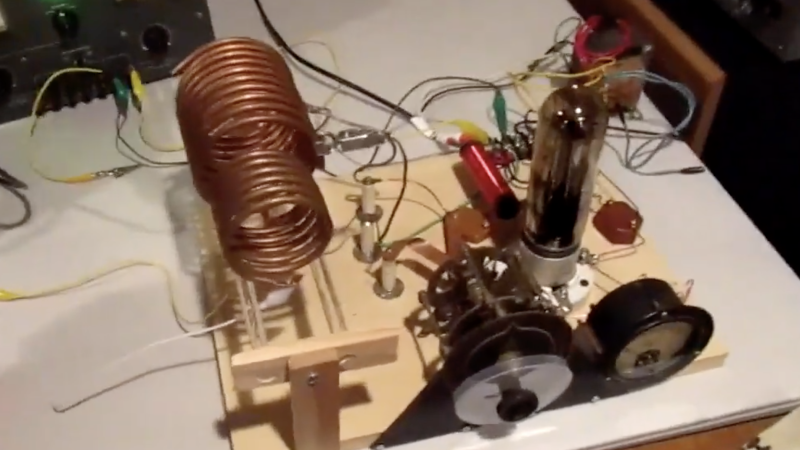The origin of the term “breadboard” comes from an amusing past when wooden bread boards were swiped from kitchens and used as a canvas for radio hobbyists to roll homemade capacitors, inductors, and switches. At a period when commercial electronic components were limited, anything within reach was fair game.
[Andy Flowers], call sign K0SM, recently recreated some early transmitters using the same resources and techniques from the 1920s for the Bruce Kelley 1929 QSO Party. The style of the transmitters are based on [Ralph Hartley]’s oscillator circuit built for Bell Telephone in 1915. Most of the components he uses are from the time period, and one of the tubes he uses is even one of four tubes from the first Transatlantic contact in 1923.
Apart from vacuum tubes (which could be purchased) and meters (which could be scrounged from automobiles) [Flowers] recreated his own ferrite plate and outlet condensers for tuning the antennas. The spiderweb coils may not be as common today, but can be found in older Crosley receivers and use less wire than comparable cylindrical coils.
A number of others features of the transmitters also evoke period nostalgia. The coupling to the antenna can be changed using movable glass rods, although without shielding there are quite a number of factors to account for. A vertical panel in the 1920s style also shows measurements from the filament, plate current, and antenna coupling.
While amature radio has become increasingly high-tech over the last few years, it’s always good to see dedicated individuals keeping the old ways alive; no matter what kind of technology they’re interested in.
[Thanks Mark Erdle for the tip!]

















The amateur transatlantic test was in December of 1921, twenty years after Marconi spanned the Atlantic. Of course, by 1921 US hams, I don’t know about elsewhere, had been relegated to the “useless” frequencies above abkut the current AM broadcast band. Spanning the Atlantic in 1921 proved that shortwave was actually valuable.
Forty years later, in December 1961, OSCAR 1 went into orbit.
Michael
Very cool Andy ! I applaud your craftsmanship ! 73, Mark, WN3SIX
“. The spiderweb coils may not be as common today, but can be found in older Crosley receivers and use less wire than comparable cylindrical coils.” That sounds like the exact opposite of what was said on video.
Not finding the bit about ferrite plate either, but I’m up late and been dotting around in the vid.
This is brilliant! Physics laws don’t change, just the way we achieve inductance, capacitance or whatever we require. If some of our modern operators could “see”see” how you are ‘achieving your coupling’ etc. they would gain actual understanding as to what is really happening in Pi networks etc. instead of just ‘twiddling the knobs willy-nilly ‘ with no concept of what is really happening
Some of us modern operators do in fact understand the concepts at play inside of a transmitter. :D
Thank goodness for decent elmers, eh? My father was my primary elmer both for amateur radio and electronics in general. Most of what I have learned over the years has been built upon the foundation of what he taught me.
Yeah, theoretically we’re (ham operators) are supposed to know the theory behind the electronics in our transceivers. In practice, most of us probably couldn’t pass the test again if we weren’t given the answers ahead of time – which is the case in the US at least.
The theory is that we’re supposed to be able to build and service our own equipment in the wake of catastrophic events. The reality is most of us couldn’t do so because our actual radios are proprietary black boxes made from largely non-user serviceable integrated circuits and closed source firmware.
I love seeing the cases where that’s not true though with bread board radio equipment in the finest tinkerer’s traditions like these in the video.
i am ok with non rohs complaince if it means lower prices
While super awesome am I the only one that feels that coil belongs in a museum somewhere? Not sure how easy it is to rebuilt…
Video was removed from censorTUBE ,
please consider mirroring it onto bitchute